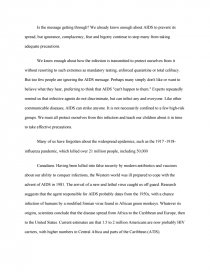Aids
Essay by review • November 4, 2010 • Essay • 1,031 Words (5 Pages) • 1,712 Views
Is the message getting through? We already know enough about AIDS to prevent its spread, but ignorance, complacency, fear and bigotry continue to stop many from taking adequate precautions.
We know enough about how the infection is transmitted to protect ourselves from it without resorting to such extremes as mandatory testing, enforced quarantine or total celibacy. But too few people are ignoring the AIDS message. Perhaps many simply don't like or want to believe what they hear, preferring to think that AIDS "can't happen to them." Experts repeatedly remind us that infective agents do not discriminate, but can infect any and everyone. Like other communicable diseases, AIDS can strike anyone. It is not necessarily confined to a few high-risk groups. We must all protect ourselves from this infection and teach our children about it in time to take effective precautions.
Many of us have forgotten about the widespread epidemics, such as the 1917 -1918-influenza pandemic, which killed over 21 million people, including 50,000
Canadians. Having been lulled into false security by modern antibiotics and vaccines about our ability to conquer infections, the Western world was ill prepared to cope with the advent of AIDS in 1981. The arrival of a new and lethal virus caught us off guard. Research suggests that the agent responsible for AIDS probably dates from the 1950s, with a chance infection of humans by a modified Simian virus found in African green monkeys. Whatever its origins, scientists conclude that the disease spread from Africa to the Caribbean and Europe, then to the United States. Current estimates are that 1.5 to 2 million Americans are now probably HIV carriers, with higher numbers in Central Africa and parts of the Caribbean (ATIS).
AIDS is not just a public health problem; it is a major development crisis. Because it kills so many adults in the prime of their working and parenting lives, it destroys the workforce, fractures and deprives families, orphans millions, and shreds the fabric of communities.
AIDS stands for Acquired Immune Deficiency Syndrome. Acquired means you can catch it; Immune Deficiency means a weakness in the body's system that fights disease; and syndrome means a group of health problems that make up the disease. A virus called HIV causes AIDS: Human Immunodeficiency Virus (Piot). HIV weakens the immune system. The infected person may develop problems in fighting certain infections. The diseases acquired usually kill the person. It is not know for sure what percent of persons infected with the AIDS virus will actually develop AIDS or become ill. The virus can be transmitted soon after the person becomes infected. This is true even if the person does not develop AIDS.
The AIDS virus is present in semen and blood. The AIDS virus is not highly contagious. Sexual contact and sharing IV drug needles and syringes transmit it. The virus can also be passed from a woman to her fetus or newborn child. Anyone, heterosexual, homosexual, or bisexual engaging in risky sexual or drug-abusing behaviors with an infected person can get the AIDS virus.
AIDS is becoming a global epidemic. No country is safe from it. There has been AIDS cases reported around the world, in such places as the Caribbean, Southeast Asia, Southeast Mediterranean, and Oceania. This helps to show that AIDS knows no geographical boundaries. This disease has been likened to the Black Plaque that destroyed Europe during the middle ages (Weitz).
AIDS has already resulted in the deaths of approximately 18.8 million worldwide and will ultimately cause the deaths of the estimated 34.4 million men, women and children around the globe still living with the disease.
...
...



